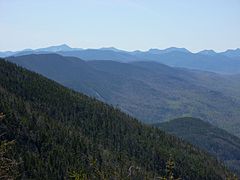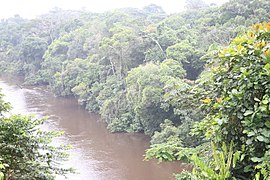Canespa: Difference between revisions
PotatoLover (talk | contribs) mNo edit summary |
PotatoLover (talk | contribs) mNo edit summary |
||
| Line 2: | Line 2: | ||
|conventional_long_name = Congressional Company of Canespa | |conventional_long_name = Congressional Company of Canespa | ||
|native_name = Canespa | |native_name = Canespa | ||
|image_flag = | |image_flag = Canespa Flag1.png | ||
|alt_flag = <!--alt text for flag (text shown when pointer hovers over flag)--> | |alt_flag = <!--alt text for flag (text shown when pointer hovers over flag)--> | ||
|flag_border = <!--set to no to disable border around the flag--> | |flag_border = <!--set to no to disable border around the flag--> | ||
| Line 11: | Line 11: | ||
|alt_coat = <!--alt text for coat of arms--> | |alt_coat = <!--alt text for coat of arms--> | ||
|symbol_type = <!--emblem, seal, etc (if not a coat of arms)--> | |symbol_type = <!--emblem, seal, etc (if not a coat of arms)--> | ||
|national_motto = The land of few is the land of prosperity | |national_motto = Pisi runakunaq hallp'anqa allin kawsay hallp'an | ||
|englishmotto = The land of few is the land of prosperity | |||
|national_anthem = Your song | |national_anthem = Your song | ||
|royal_anthem = | |royal_anthem = | ||
| Line 25: | Line 25: | ||
|capital = Canestapa | |capital = Canestapa | ||
|largest_city = Canestapa | |largest_city = Canestapa | ||
|official_languages = | |official_languages = Papasimi | ||
|ethnic_groups =Canespian | |ethnic_groups =Canespian | ||
|religion = M'acunism | |religion = M'acunism | ||
|demonym = | |demonym = Canespian | ||
Canespian | |||
Canespian's | |||
|government_type = Banana Republic | |government_type = Banana Republic | ||
|leader_title1 = Wasiexu | |leader_title1 = Wasiexu | ||
| Line 54: | Line 54: | ||
|time_zone = <!--e.g. GMT, PST, AST, etc, etc (wikilinked if possible)--> | |time_zone = <!--e.g. GMT, PST, AST, etc, etc (wikilinked if possible)--> | ||
|electricity = <!--e.g. "230 V–50 Hz"--> | |electricity = <!--e.g. "230 V–50 Hz"--> | ||
|drives_on = | |drives_on = Right | ||
|cctld = | |cctld = | ||
|calling_code = <!--e.g. [[+1]], [[+531]], [[+44]], etc--> | |calling_code = <!--e.g. [[+1]], [[+531]], [[+44]], etc--> | ||
Revision as of 23:17, 18 January 2024
Congressional Company of Canespa Canespa | |
|---|---|
Motto: Pisi runakunaq hallp'anqa allin kawsay hallp'an The land of few is the land of prosperity | |
Anthem: Your song | |
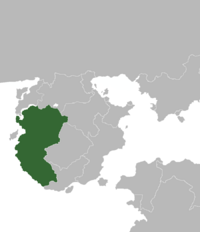 Location of Canespa (green) in Cusinaut (gray). | |
| Capital and largest city | Canestapa |
| Official languages | Papasimi |
| Ethnic groups | Canespian |
| Religion | M'acunism |
| Demonym(s) | Canespian
Canespian Canespian's |
| Government | Banana Republic |
• Wasiexu | Túpac Amaru |
• Your head of government if applicable, otherwise a legislative leader | Jane Blow |
• A legislative leader of a different house, if applicable | Georgw Blow |
| Legislature | House of Union |
| House of Union | |
| None | |
| Establishment | |
• An event | A date |
| Population | |
• Estimate | 87,300,000 |
| GDP (nominal) | estimate |
• Total | Your GDP = GDPPC x Population (This is calculated for you after first entry) |
• Per capita | 29,507 |
| Gini | Your gini coefficient Error: Invalid Gini value |
| Currency | Capesa (CPA) |
| Driving side | right |
| Today part of | None |
Canespa, officially the Congressional Company of Canespa, is a country in Cusinaut. It is neighbored by , Netansett, and Porfiria.
Canespa is a Semi-Monarchical Congressional Company made up of seven houses meaning that it is controlled by a company. After so many years of molding with the government the Canasta Company and the government became one in the same. Thanks to this Canespa values nothing more then its farmland. Especially around the Chawpi Valle, the Wallowaki mayu, and the vast hills of Canespa with there terrace farms.
Canespa is a member of the League of Nations.
Etymology
Canes comes from the word "Canasta" which means Basket in the Papasimi Dialect. The first use of this name is unknown but it likely dates back thousands of years to some small tribe in the region. While pa comes from the word Potato. The meaning of these two words is vary significant to Canespa as they represent the country. While no one knows the original use of basket in the countries name it most likely came from a small tribe somewhere in Canespa that eventually found its way into Canespa's name sake. While the baskets origin is must more wondered upon, the Potato in Canespa's name came directly from House Papa and exstensive worship of the starchy food. It also is vary important to Canespian culture as a whole.
History
First era
The first signs of human inhabitants within the region originate in around 19,000 B.C.E as early forms of scavenging tool and clothing have been found.
Second era
During the 8th through 14th century the country slowly began to centralize more into a state. The different families and clans slowly began to decrease in number but after the fall of House "Metal" in 1395, the clans stagnated as any move against one another would break the balance of power that existed. This all changed thanks to the Wasi King in 1458. He was a member of House "Light". The Wasi King proposed that all the houses form together and create the country of Canespa. A country that could withstand the forces of any neighboring land. The houses were convinced by both by the Wasi King's legendary speaking skills and the looming threat of colonizers in the area. For the next 300 years Canespa would almost totally remove itself from the world.
The Wasi King
The Wasi King has been a major individual and title that has greatly effected Canespa up to the modern day. The Wasi King first appeared in the year 1157. He was able to unite four of the houses at the time with a great war headed by the House Wasi. Who conquered House Kuskachay, House Espada, and House Kanchi. Though this union was short lived it cemented the concept of the Wasi King. Any person or persons that united multiple houses would be known as the Wasi King. There name(s) would also converted to Wasi and they would be regarded as one individual. The Wasi King was the supreme ruler up until the Canasta Company gained full control of the government in the 60s. Though some argue that the board of executives is the Wasi King. The board has interestingly never claimed this title and has effectively ended the tradition somewhat.
Third era
The reign of the Wasi King lasted for ages, and it brought relative prosperity to area. The country slowly expanded in a small series of conflicts that shaped the modern borders of Canespa.
Fourth era
During the Age of Sail Canespa and the Maritime Deric Duchy of Martilles formed an alliance that guaranteed that no Occidental power would try to colonize Canespa.
Fifth/Sixth era
The Canasta Company is one of the products of the 19th century. It revolutionized almost everything about the country.
Geography
-
First lovely location
-
Second lovely location
-
Third lovely location
-
Fourth lovely location
-
Fifth lovely location
-
Sixth lovely location
What is the general explanation of how your country exists within the world?
Climate and environment
Canespa, while being the in the far north of the planet, maintains a mild climate thanks to the currents of the ocean to its west. This has helped it maintain a climate suitable for farms. Canespa's soil is thin and grainy which means it is perfect for the growth of potatoes. This soil has effectively shaped canespa's history into one of a rich monoculture that can produce more food then its people would ever need and more.
Government and Politics
Canespa is effectively ruled by the Canasta Company. But its still split into two "branches" including the Board of Executives and the House of Union.
Executive
The countries Executive branch is lead by the Board of Executives a 12 person council. There is a mandated two members from each of the houses. Additionally one member is mandated to be a foreigner from a foreign branch of the company. Since this position was mandated it has been controlled by Burgoignesc individual. The last member is the head of the council. They are required to be from House Wasi. This individual most be either a child or grandchild of the previous council head above the age of 25. The council heads official position name is the Wasiexu (Was-ee-x-oo). The Wasiexu is the effective CEO of the Canasta Company. The Board of Executives is in charge of all of Canespa's foreign relations and most of its economic decisions.
To Become A member of the Board of Executives a person must be of atleast the age of 25 (though this is rare) and have proved themself within the Canasta Company working there way up the chain of command. Each executive is required to have a designated heir that holds a high ranking position in the company while also being of the same house. As for the Wasiexu. They are voted on by the House Union. Usually there are only 3-4 runners for the position considering the strict requirements. Additionally the foreign spot is chosen by the other executives and not by the previous foreigner.
Federal subdivisions
The country while mostly governed from the capital Canestapa has sub divisions based upon the Qumir Canals. These divisions were created by the Canasta Company in order to manage the country better, 13 of these divisions exist. They mean almost nothing on a political level but they do have some economic differences and each one has a center city (capital) which is usually the city at the start of the regions canal system. Each division needs to report its harvests and all of its transports.
Politics
The only place where any pseudo parties exist is the House of Union. Since worker unions are illegal in the country, an alternative was created in the form of the House of Union. Its job is to make sure the houses left over from the Wasi-King are reigned in and happy. Each house controls a certain amount of members in a 275 person senate. This senate will vote over cultural and internal issues. Effectively acting as a guard to stop extremest Executives from gaining to much power. This senate has little power though and is not always effective. The houses include House Papa, House Espada, House Kuskachay, House Qispisqa Kay, and House Kanchi. Historically House Kanchi has reigned supreme but since 1994 House Papa has held a commanding lead. Bribery is common within the House of Union. Different Executives will occasionally bribe entire houses in order to gain more power within the country.
The house will vote on bills passed to them by the countries executives. There are different types of bills that require different percentages of the house. The main three are economic, law, and defense. A bill can be passed to the House of Union once any number of executives have signed the bill. The percentage needed to pass any bill starts at 92.5% with one executives signature and goes down by 7.5 percent with every additional signature. Defense bills add 10%, Law bills don't effect the percentage and Economic bills subtract 10%. The percentage needed to win maxes out at 92.5% while the minimum percentage needed for any bill is 10%.
Law
The Countries effective judicial system is the Human Resources Commission. Or the HRC which is directly related to the Canasta Company. Since the disolution of the Libre Tribunal in 1986 the HRC has handled all judical affairs within the nation.
Demographics
Ethnicity
The main ethnic group in the country is Canespian which consists mainly of anyone from the 7 Houses. Though Canespa is a big place so most of the time its split into two, Southern Canespian and Northern Canespian. Northern Canespian is the bigger of the two ethnicities being roughly 68 million strong. While there are only roughly 20 million southern Canespians the culture is even more rural then its northern counterpart.
Language
Papasimi is the official language of Canespa. The language is thousands of years old and has not spread far out of Canespa. It was used for a small amount of time in the more western areas of the Northern Federation but it died out there after the collapse of the federation. The languages origin point is often debated by scholars. While some say it most likely came from the mountains do to many of the mountains in the region having there names deeply rooted in the language while others believe that it started along the coast which would have allowed it to spread faster. Even some believe that it didn't originate in the Cusinaut at all and came from the mainland thousands of years ago in small tribes.
Religion
Religious affiliations in Canespa (2033)
Education
Education up to ones 12th birthday is mandatory and training programs are free if you agree to go into that profession after the program is over. This means that in a general sense most Canespians are educated. Only a few training programs are deemed as higher education by other countries though. So only around 4% of Canespians engage in high education.
Culture and Society
Education
In Canespa, general education for most only lasts till ones 12th birthday. At which point they will start a training program for whichever profession they will ultimately spend most of their life doing.(75% will be in some type of farming) Most training programs last from 2-4 years at which point one will start working. To become a teacher of general education one most pass specific tests and strict backround checks, becoming a teacher or trainer is not easy in Canespa.
In order to qualify for a certain training program you need to either have shown certain skills by doing skill camps in your younger years or maintain certain grades for more executive type training programs. Skill camps are week long camps that you can decide to participate in during your general education. For 3 separate weeks during the school year school is canceled and skill camps open up in there place. There are fall, winter and spring skill camps. Some skill camps only have one location in the country while some have many. Some notable skill camps include the football camp, the harvesting camp, the planting camp, the leadership camp, the peace and order camp, the military camp, the technology and discovery camp, the religious studies camp, and last but not least the politics camp.
Attitudes and worldview
The people of Canespa view life as a connection to the earth that individuals have to play a part in. In their opinion other countries lack a connection to the earth, and that this will play a role in most of there failures. They believe that in order to maintain balance Canespa must keep its connections to Mother Nature in order to feed the people of the world. The Canasta Company while being a government and corporation plagued with corruption and power hungry individuals has always, under the guidance of House Wasi, kept its promise of maintaining its connection to the Earth and guaranteeing the safety of the people.
Kinship and family
Families are led by both parents but the rules of the houses dictates that the children of the couple are part of the fathers house and the mother is allowed to convert to the husbands house at marriage if they are not part of the same house. This has led to parents wishing for more male children that will lead to the growth of there house. The only house that is exempt to this rule is House Wasi. House Wasi is only passed on through the eldest son or daughter of the Wasi House head. While all of the children of the houses head are part of the house, they can not pass it down to their children. If the eldest son or daughter has no children then the children of a different son of daughter will be able to pass down House Wasi even if said children are not part of House Wasi. These complex rules were created by the Wasi King in order to sway the other houses into further joining his united Canespa. By sacrificing his houses size and representation he convinced the other houses of his intentions of building a better Canespa.
Cuisine
Potato's are the staple dish of the Canespian people. Canespians are known for there ability to make a different potato themed dish for ever day of the year. This was born out of necessity as the government of Canespa gives out rations accordingly to the person. Most of the time these rations come in form of potatoes about 60% of the time. Most take these rations in exchange for less pay. Potatoes have been the main dish of Canespa since before the days of the Wasi King. They have caused many diplomatic incidents within Canespa and they have been a symbol for many things including one of the houses, different revolts and wars across the years, and multiple laws.
House Papa is the house of potato. Thanks to the efforts of the Canasta Company House Papa became the largest house in 1994. This was pushed by the Company for many reasons but the biggest of which was the large monoculture farming the House participated in. For sustainability reasons the monoculture has been brought back a bit but is still a major factor in the nation. While this does make the nations food production slightly more vulnerable, the Canasta Company knows this and has placed strict laws on what enters the company. All vehicles attempting to enter the country are searched for all traces of any fruits or vegetables.
in 1659 the Canespian Houses were conducting a fairly ordinary yearly ritual to pray to Makuahine and her givings. This would have been an event that could barely be mentioned but during the ritual House Kanchi brought a tomato (There main crop) to the ritual instead of the mandated Potato that this specific ritual mandated. This lead to House Papa being deeply enraged. Thus leaving the country on the verge of civil war. If it wasn't for the other houses stepping in and stopping it, it could have ended Canespa. As a peace deal House Kanchi and House Papa made a new dish mixing both tomatoes and potatoes in an elegant blend that stunned administrators and even the Wasi King himself with its savory and beautiful taste. Though this dish has been lost to history its taste is said to still linger in the mouths of all Canespians.
Religion
Religion in Canespa is majorly identifies with M'acunism. The people of Canespa through there isolation formed there own school of teaching within M'acunism. Known as the Nature school is a slightly different form of M'acunism that instead of focusing on the hierarchy of animals focuses more about the connection to the planet that the Great Oneness has. Individuals from the Nature school believe that while there is a hierarchy, plants are a part of it. This is different from the other schools as they focus specifically on the animal kingdom. They also believe that any use of mother natures resources in a destructive way directly harms her. This influences the laws of Canespa in that all types of fossil fuels are outlawed with a few exceptions like the military.
The state has a mild connection to the religion. The Wasiexu is required to follow M'acunism. While other executives are not required to follow the religion, they all do. M'acunism in Canespa has held strong against Christian missionaries for centuries. This has been thanks to the belief that all the stories of the bible are centralized to one location, and do not reflect the actions of an all powerful being. It is also thanks to the isolationism that Canespa took part in for centuries that this school spread.
Arts and Literature
Although Canespa is not known for its music it has a couple notable country artists. Its mainly known for its artistic 3d sculptures made up of many things from nature including fruits and vegetables, grass, flowers, and even dirt held together with preservatives to stop the food from going bad. These sculptures are known as Rurukuna Rikuchiy. The largest known piece of rurukuna rikuchiy was made and sculpted at the entrance of Hamuq City.
Sports
Canespa does not have large programs for many sports. But it does have notable Football (American) League known as the Canespian Football League or the CFL. There are 12 teams in the CFL that all compete for the top four records in the main season in order to enter a four team playoff. The CFL is split in the SCFL (Southern Canespian Football League) and the NCFL (Northern Canespian Football League). Each league sends two teams to the playoffs who play in the Canespian Potato Bowl. The winners famously get to enjoy a massive feast with the Wasiexu and other notable members in the countries government.
Symbols
The Potato Flower is the main symbol of the country and is the logo of the Canasta Company. It is also used to represent the Nature School of M'acunism. The first use of this as a symbol of Canespa was in 1198 when House Papa carved the flower into there war canoes. The use continued and eventually spread to other houses before becoming the man symbol of the Wasi King and his power. It was and still is a fashion for girls to wear a potato flower in there hair. The flower is even used in the seal of Canespa.
Economy and Infrastructure
Hamuq City
Hamuq City is a futurist massive infrastructure project located in ____. It a futuristic and technologically advanced farming city. It is a 0 carbon emmision technologically advanced farming city made up of 8 massive towers each of which produces enough food to feed millions a year. They are climate controlled buildings that can produce food 24/7 365 days a year. The city is expected to be finished in the year 2035. Hamuq's towers will use biofarming and microfarming in a mechanized form of farming. This means that the small area that Hamuq takes up will produce more food per square kilometer then anywhere else in the world. The only part left in construction is the filling of a massive reservoir that will be adjacent to Hamuq.
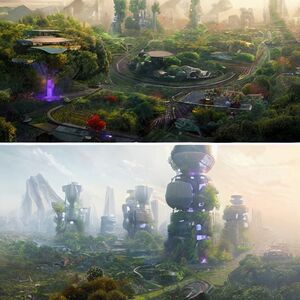
Industries and Sectors
The largest economic sector is the farming industry by a long shot. Exporting food makes up 87% of Canespa's industry, 8% is made up of dams and waterway fees. and the remaining 5% is other industries. Canespa has a rich history of farming in the Cusinaut. This caused them to be a vary tribal nation up until the 60s when the Canasta Company gained control of the government. The company was started in the 20s and slowly grew threw the decades. Its strategy from the beginning was to fill a niche and profit greatly from it. Despite the vastly more profitable option of industrializing, Canasta's leadership decided to play the long game as it predicted massive food shortages that would come with urbanization.
Thanks to the hilly area around Canespa, terrace farming has become a wildly used strategy that spans much of the countryside. These farms are all owned by the Canasta Company and worked by its employees. They are then brought to Port Extranjero using the extensive Qumir Canals. Once they reach Port Extranjero they are exported around the world. This is how Canespa functions as a state and how they can afford the building of large infrastructure projects like Hamuq City.
Currency
In 2027 Canespa updated its currency into the Capesa. An (almost) completely digital style of currency exchange. The Capesa is digital form of currency that is backed by electricity. One Capesa is equal to one Kilowatt of electricity. While this does lead to a slightly harder to control currency it means that Canespa can engage in trade deals with other nations that result in direct energy transfer. Thanks to this Canespa produces little energy of its own. Instead it imports most of its energy from other countries in exchange for food. Before this, Capespa was using the Taler because of its connections with Burgundie as they were the main trade partner of Canespa.
Do to the unstable nature of an energy based currency, Canespa has laws in place that allow for a rapid shift in how much things cost and how much employees are paid. It also leads to more Capesa's being dealt out whenever more energy starts to be produced. Of course due to the nature of the Canasta Company taxes are irrelevant and no taxes exist in the country. All the money paid out to employees is eventually used to buy goods which means the Canasta Company will get all of there money back eventually.
Healthcare
Medical care is provided by the Canasta Company, because of the agricultural nature of Canespa the hospitals in the country are required to possess at least 3 electric helicopters. This is so that they can quickly reach any point in the country and back to a hospital as quick as possible.
Labor
Labor is all controlled and conducted by the Canasta Corporation. While individuals do have a choice in profession, if one job is lacking numbers they will take less skilled individuals from others to make up for it. Most citizens end of in farming as its seen as a good hard working profession in Canespa.
Transportation
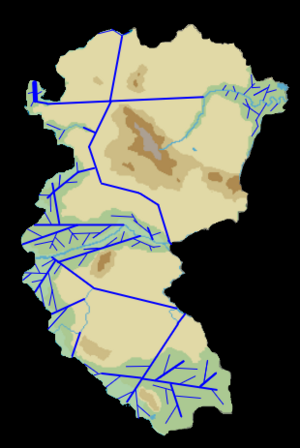
The people of Canespa get around using the Qumir Canals. A massive canal network within the country that is used to transport everything from military equipment to food to even people. In addition to the canals there is a high speed rail network between Canestapa, Port Extranjero, and Hamuq Cities construction cite. There are smaller outshoots of this rail network connecting to the smaller coastal cities of Canespa but these rail networks are expensive and not entirely tested so the canals have remained the main transportation device within the country.
Energy
Most of the people of Canespa have not had access to electricity till around the 1980s. Today most of the countries electricity is imported while some of it is brought in through dams built along the rivers flowing down from the mountains. These dams supply about 40% of Canespa.s electricity requirements, while the rest is imported from the Cusinaut and Crona. Canespa is strictly against fossil fuels and any type of high pollution energy source. This is due to the belief that using these fuels directly harms the mother nature herself.
Technology
Canespa has a small science department in most fields and usually relies on importing new technology into the country. One of the only major focuses of Canespa's science department is its agriculture division. Hamuq City relies heavily on this new farming technology that revolutionizes the amount of food that can be produced per worker. The department has experimented with genetically modifying plants and has made strides in the amount of time it takes the Potato plant and Tobacco plants to regrow. The potato plants growth time alone has been cut in half to around 30 days. The department also works on the development of new field equipment and has produced the Granjero Gen V and Gen Vl Tractors. These Tractors are absolute beasts that use treads instead of wheels causing less soil damage. They also have a 745 horsepower completely electric engine. The department has already started work on the Granjero Gen Vll which is expected to come out in 2036.
Military wise the department has made the Mayu Uywa. A mechanical beast of a machine that was designed for the defense of Canespa. The Mayu Uywa crawls along the bottom of the canals, if there is a threat it will pop out of the water within 10 seconds and begin an onslaught of fire from its 4 mini turrets. The Mayu Uywa also has a main battle turret that is large enough to completely destroy enemy tanks within range. The country currently has 17 of these beasts roaming the depths of the canals.
Military
Canespa's armed ground forces number 193,706 active members while there are 985,000 reserve members. The Canespian army, while fairly untested has shown its ability exert force as military parades are common in the country.
In 1996, Burgundie bought 3 AMY-82s from Yonderre and sold them to Canespa for field testing. In 1998, the Canespan's adopted the AMY-82s and bought 15 more of them from Yonderre through Burgundie. That same year Burgundie sold Canespa 2 each, Tiger attack helicopters and Tucanos for training and evaluation. In 2000, the Tiger attack helicopter and Tucano were adopted and Canespa purchased 18 of each. In 2012, Canespa bought 10 more AMY-82s for a total of 28 and 6 more Tiger attack helicopters for a total of 26. In 2022, Burgundie bought back the Tucanos to be sold to an Audonian power, in exchange for 14 Super Tucanos. In 2025, Burgundie sold Canespa 27 more AMY-82, for a total of 55, completing the formation of its tank regiment.



